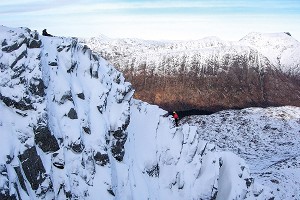
Of all Scotland's iconic winter mountains, Lochnagar holds perhaps the greatest mystique. Isolated from the honeypot venues of the Northern Corries to the north, and guarded by its long windswept walk-in, the great north-east corrie feels in another age, a brooding pagan god opening its granite jaws to tempt trespass by the brave. Modern gear has done little to tame this beast. Bottomless powder, crusty ice, verglas, smooth slabs, rounded bulges and blind seams offer equally insecure purchase to today's leashless axes and monopoints as given to the triconis and slaters hammers of early pioneers. Yet perversely, this inhospitality evokes a strong pull upon loyal suitors seeking physical and mental challenge. Their hard fought, and harder won endeavours make Lochnagar a forcing ground for the cutting edge of Scottish winter climbing.
A Brief History
Lochnagar saw relatively little attention until the post-war, when a flurry of activity by members of the recently founded Aberdeen University Lairig Club and other Aberdeen based climbers brought the mountain to the fore of Scottish winter climbing. As well as conquering the great gullies (Douglas Gibson V 4) and Polyphemus Gully (V 5) (V 5), they sought winter ascents of the few established summer lines. The crowning achievement of this 'Golden Age' was the 1953 winter ascent of Eagle Ridge (VI 6) by Bill Brooker, Tom Patey and Mike Taylor. Only climbed in summer a decade before following a protracted campaign, their four and a half hour first winter ascent remains the stuff of legend. Arguably the hardest winter route of its day, it still regularly repels or stretches climbers' efforts well past nightfall.
During the front-pointing revolution a period of consolidation followed, the next major leap in standards coming from the one and only Andy Nisbet and John Anderson's Link Face (VII 7) in 1979. Over the following decade, Nisbet and partners developed many of the mountain's modern mixed classics and made the first breaches of Lochnagar's most revered (and feared) crag, the sweeping slabs of the Tough-Brown Face. Success on many of these lines, a theme to be repeated, took multiple attempts with repeats of the likes of Trail of Tears (VII 7) (VII 8) and Diedre of the Sorrows (VIII 8) (VIII 8) still rare.
Elsewhere on the mountain, the 90's saw detailed exploration of the possibilities from Scottish winter's most dedicated devotee Simon Richardson. Climbed with long time partner Chris Cartwright, The Link Direct (VIII 7)(VIII 7), is regarded as one of the very best winter climbing adventures in Scotland – and therefore the world!
Lochnagar, in particular the Tough-Brown face remains a forcing ground for the bold and brave. Mort, Scotland's first grade IX, finally succumbed to Brian Davison, Andy Nisbet and Dave McGimpsey in 2000 after multiple attempts spread across the previous15 years. It waited another 13 years to be repeated. Adjacent, the line of the summer E2 Nevermore (X 10), requiring multiple attempts from a team of Scotland's best winter climbing talent to unlock its secrets, marks the latest high water mark for Scottish winter climbing. With a Scottish winter renaissance in full swing, what challenge will next be pioneered on the cliffs of Lochnagar?
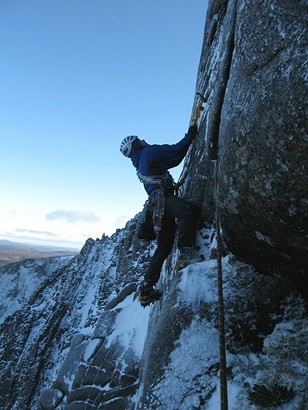
Cliffs and Climbs
The long exposed approach, and less travelled (aside from a handful of ultra-classics), lengthy and more often than not 'stern' for the grade routes give Lochnagar a deserved reputation as a proper day out.
At first glance, Lochnagar has a deceptively straightforward layout. The standard approach from the car park at the Spittal of Glenmuick crosses the high col between the subsidiary summit of Meikle Pap and the bulk of Lochnagar, laying out the cliffs around the arc of the North-East coire below. On closer acquaintance, these cliffs reveal their greater complexity – the sweeping faces and sidewalls of the major gullies conceal many grooves, ribs and chimneys. The routes themselves often take intricate, and on the topo seemingly wandering lines. Their logic is forced by the rock itself – promising-looking corners turn out to be blind seams and overlaps block progress forcing excursions to find weaknesses and seek cracks and protection. Plentiful turf, and in the right conditions, plated ice assist progress, but limited protection compared with the more cleaned-out 'snowed up rock' of the northern Cairngorms.
Not requiring descent into the coire itself the Southern Sector, reached by contouring left from the col, offers the most accessible routes. With a high crag base, shorter length and turfy and blocky nature these give reliable and amenable introductions to the mountain. Magic Pillar (IV 5)(IV 5) taking the steep buttress on the right hand edge of the central crag (the Cathedral) is justifiably now one of the most popular routes on the mountain.
Access to the main cliffs requires descent into the coire, the first aid box (grid ref NO 251 857) providing the traditional place from which to survey and select options. Above, the cliffs rise in a series of buttresses and walls broken by the major gullies of Douglas-Gibson Gully (V 4) (V 4), Raeburn's (II), and The Black Spout (I) (I). Starting from the left, Central Buttress is home to Central Buttress (Winter) (II)itself (II) gaining and following the crest, and a selection of harder offerings on its right flank. Next, the classic Shadow Buttress A (IV 5) presents a sharp crux that can feel mean for the grade, and the excellent Shadowlands (VI 7) (VI 7), a good introduction to harder offerings on the mountain. Separated from 'A' by Polyphemus Gully (V 5) (V 5), Shadow Buttress B (V 6) (V 6), holds a selection of bold icy offerings on its right side overlooking the easy lower half of Douglas-Gibson. Right of Douglas Gibson, the sharp crest of Eagle Ridge (Winter) (VI 6) (VI 6) remains the most sought after route on the mountain.
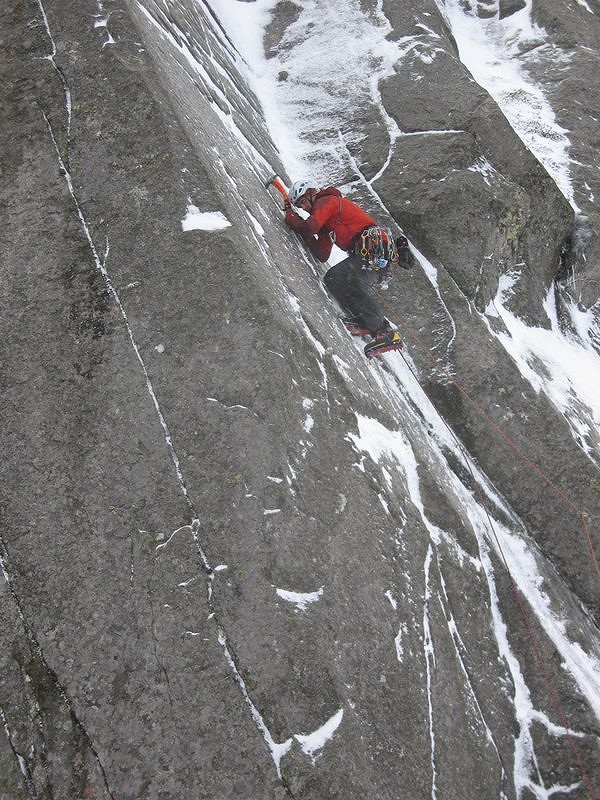
Next come the parallels – Parallel Gully A (III) (III) – at its best when iced early in the season, the testing Parallel Buttress (Winter) (VI 6) (VI 6), and the rockfall scar marking the former location of Parallel Gully B (V 5), down the corner of which a superb line of ice occasionally forms at around grade V/VI. The sweeping and a lot steeper than they look slabs of the Tough-Brown Face follow… tenuous climbing, intricate route finding and spaced protection - choose your medicine with caution!
Raeburn's Gully (II) (II) provides a scenic trip into the heart of the beast, with its sidewalls home to a growing number of routes including, for lovers of tight spaces, the spectacular deep slit of the Clam (V 6). The Black Spout Pinnacle comes next, home to among others the modern classic of Link Direct (VIII 7), and joining it the recent testpiece of Winter Black Spout Wall(IX 9).
The Black Spout (I) (I), a frequent scene of avalanche, reveals itself on closer inspection to be Y-shaped, its forks split by the Stack, which with a cliff base at 1000m can hold onto conditions when the first pitches on the rest of the cliff have thawed. Last comes the huge broken mass of West Buttress, home to a variety of little frequented routes including Black Spout Buttress (III 5), one of the better lower-grade routes on the mountain.
Two kilometres away to the west, the north facing Coire Loch an Eun (best approached from the parking at Keiloch) contains the buttress of the Stuic (I), which with the variety of routes on its flanks is a good place to seek solitude.
Conditions
The turfy nature of the cliffs and relatively low (900m) cliff base need a good freeze to bring them into condition. The length of the climbs, many exceed 200m, means conditions can vary up the route. Good conditions low down can lead to unconsolidated conditions higher up, while routes starting from high within the major gullies can remain 'in' when the first pitches of routes starting from the cliff base have thawed. Once 'in', Lochnagar's eastern location can protect it from westerly thaws better than other areas, with the downside that the snow can fail to transform. Attempting to traverse the block filled coire through deep powder is an exhaustingly familiar experience for regular visitors. The major gullies all present large avalanche hazards that threaten the coire floor, and large cornices can form particularly at the exits of Douglas-Gibson and Raeburn's gullies.
As a less frequented venue than the Northern Cairgorms, Ben Nevis or Glen Coe, conditions information can be harder to obtain. The Southern Cairngorms avalanche forecast and blog are the best place to start.
Guidebooks
The SMC Cairngorms guide is the most comprehensive, but is a pretty hefty beast to carry on the hill. The selected SMC Scottish WInter Climbs and Cicerone Winter Climbs in the Cairngorms are slimmer guides with plenty enough to keep all but the most frequent visitor occupied.
Logistics
Car is by far the easiest way to access the area, though the mountain can be approached from the A93 via public transport. The parking, note pay and display, at the Spittal of Glen Muick is the main starting point for arrival by car. Reached from Ballater by a single track road, which sometimes isn't ploughed (beware getting stranded if it snows while on the hill), the car park has a visitor centre and toilets, though these can be shut during winter. From the car, the approach uses un-surfaced road and 4x4 track, which can be tedious when icy, until a large cairn marks the start of the path that branches off to ascend to the Meikle Pap col.
Ballater has a small number of pubs and shops and limited accommodation options – the Habitat hostel is probably the most climber-friendly. Braemar (17 miles west along the A93) has additional options, and Aberdeen and surroundings are 40 miles to the east. While possible, the blocky coire is poorly suited to camping, and the exposed nature of the landscape makes staying on the hill in winter generally unattractive. There are a couple of bothies in the area which can be used as bases, but neither are on the direct approach from the Spittal of Glen Muick.
Elsewhere in the Area
Creag an Dubh Loch is the other major climbing venue in the area. Also approached from the Spittal of Glen Muick via the road alongside Loch Muick (mountain bike useful), its long east facing cliff has fickle conditions but hosts some of Scotland's most famous and sought after ice and icy mixed climbs.
Above Ballater, the Pass of Ballater crags provide the opportunity for some excellent south facing cragging, the Aberdeen area sea cliffs are within reach, and back east along the A93, the Glenshee ski centre is Scotland's largest and can provide a gentle second day to a weekend trip. Ski touring opportunities in the area are also excellent.
- REVIEW: Mountain Hardwear Mixaction and Seraction Jackets 16 Dec, 2014
- REVIEW: Petzl Sirocco Climbing Helmet 4 Aug, 2014
- REVIEW: Patagonia Adze Jacket 17 Jun, 2014
- Blue Ice Warthog 38 Rucksack 21 Aug, 2013
- Petzl Lynx and Black Diamond Stinger Crampons 6 Mar, 2013
- Marmot Ama Dablam Jacket 14 Dec, 2012
- Sea To Summit Micro McII Sleeping Bag 8 Nov, 2012
- Black Diamond Ultra Distance Trekking Poles 16 May, 2012
- Mammut Eiger Extreme Nordwand TL Boots 19 Feb, 2012
- DESTINATION GUIDE: Stob Coire nan Lochain - Glen Coe 26 Oct, 2011



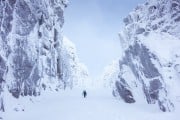


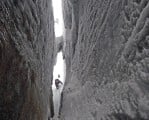



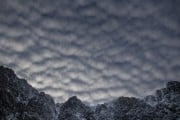
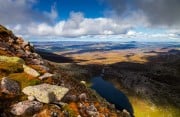
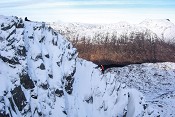
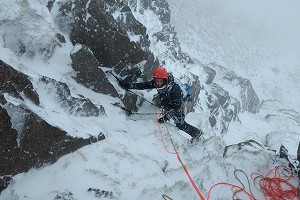

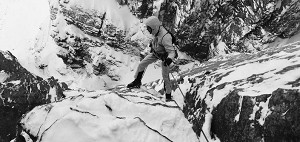




Comments